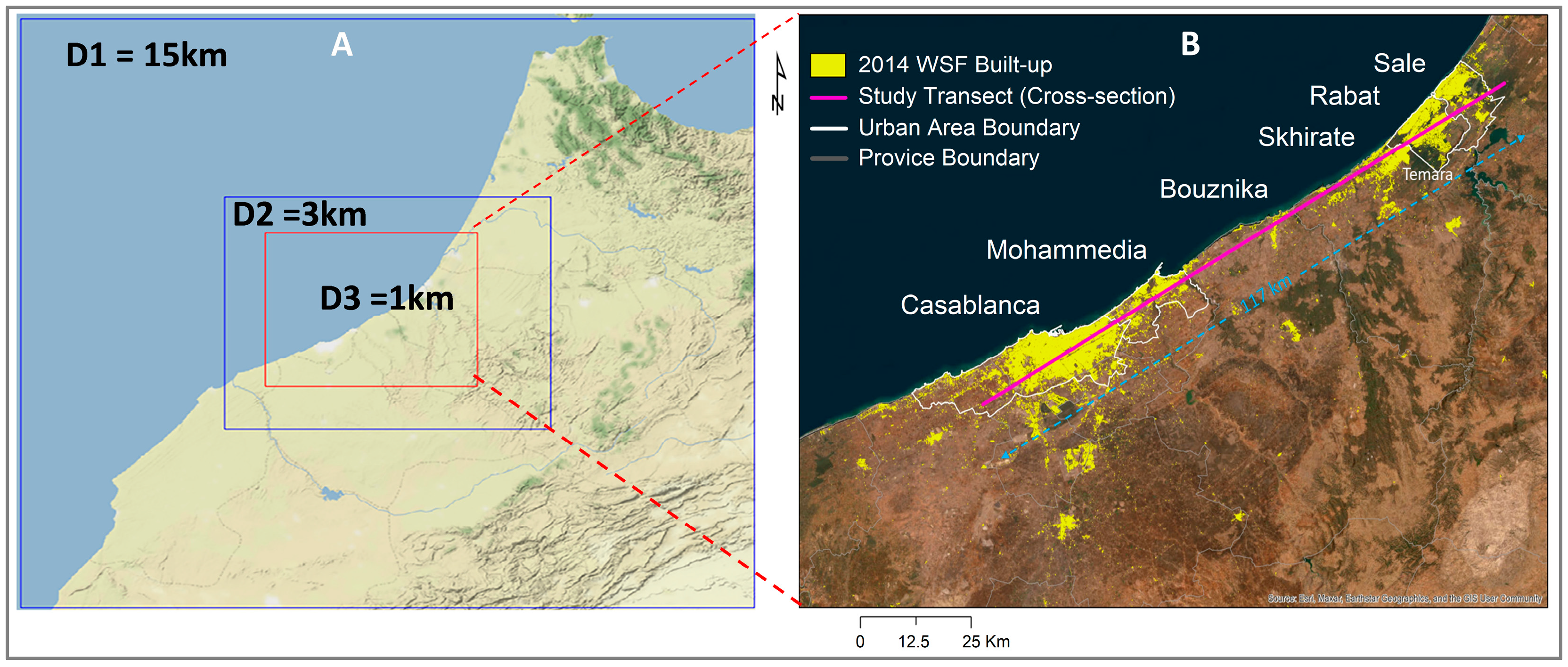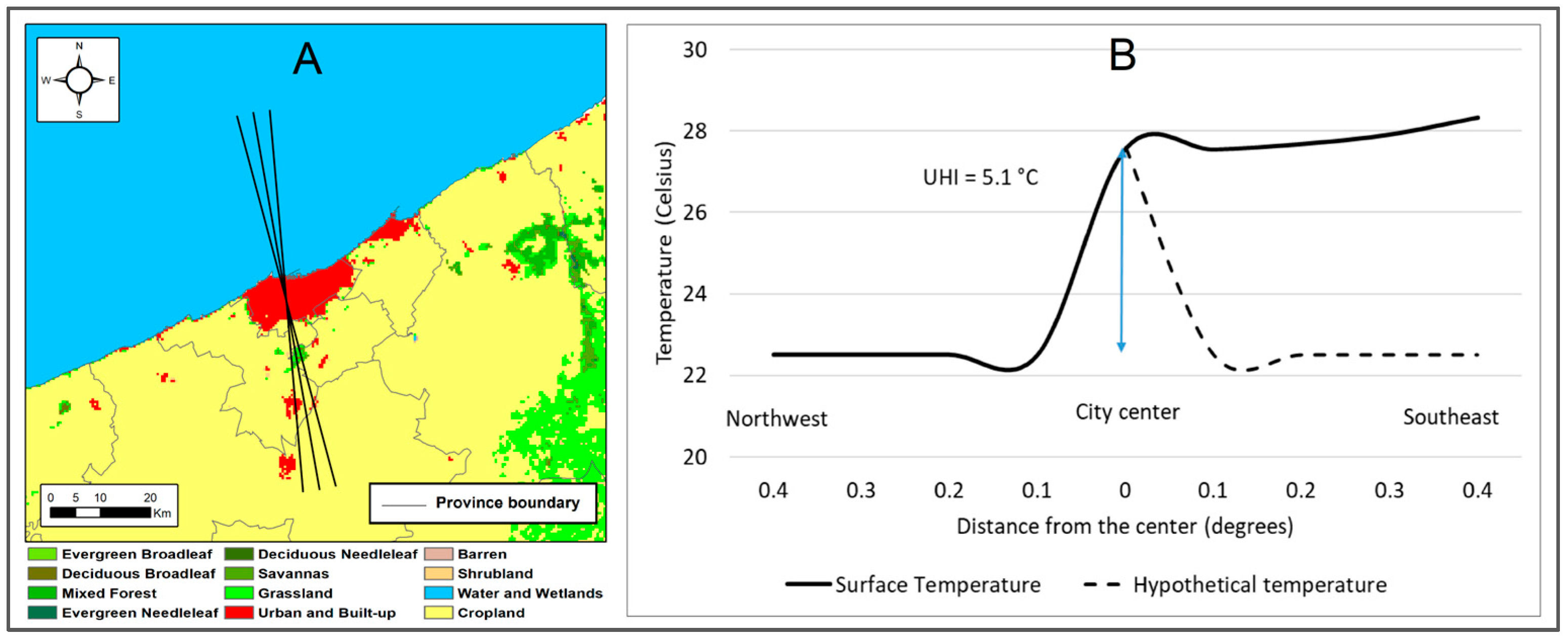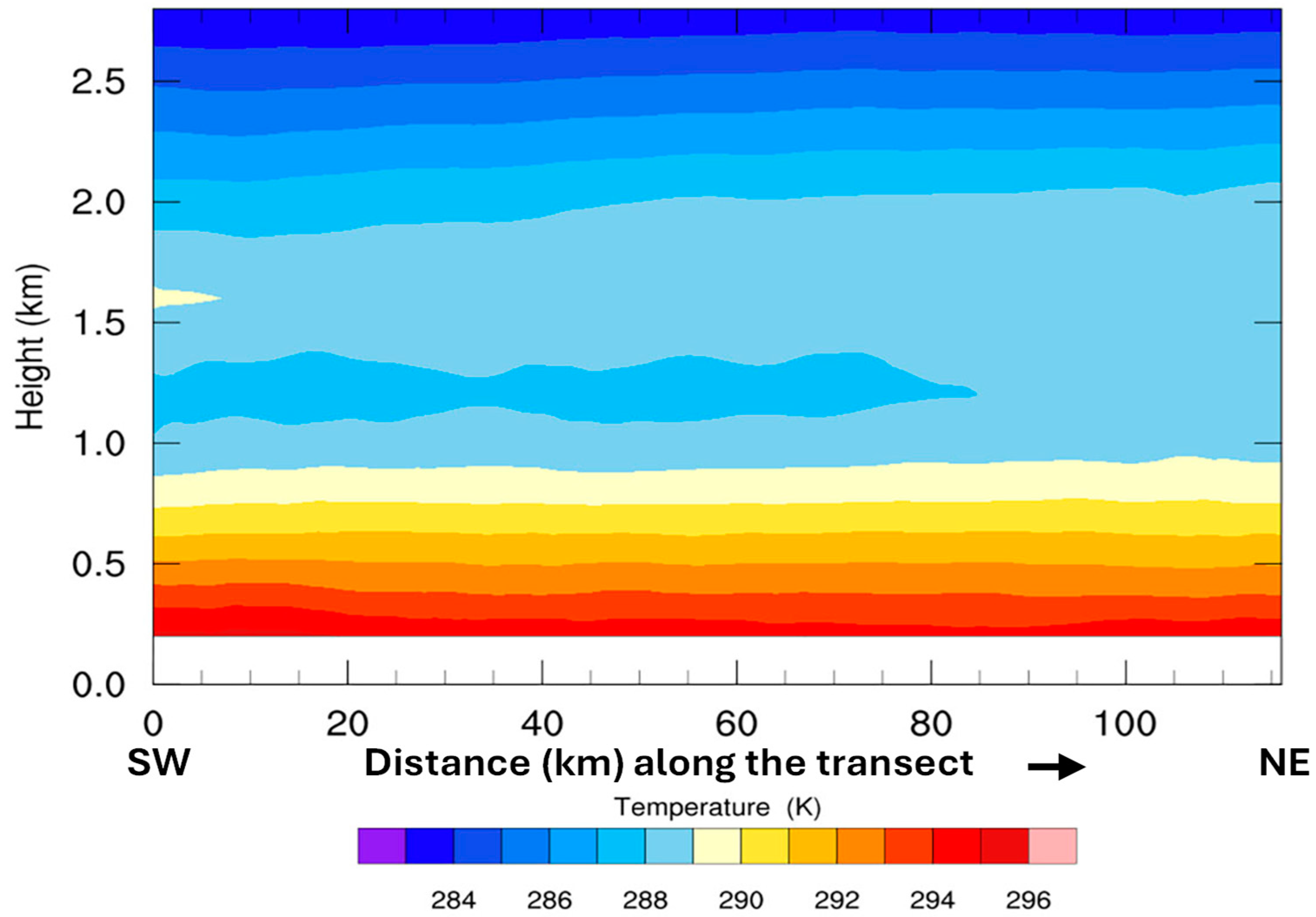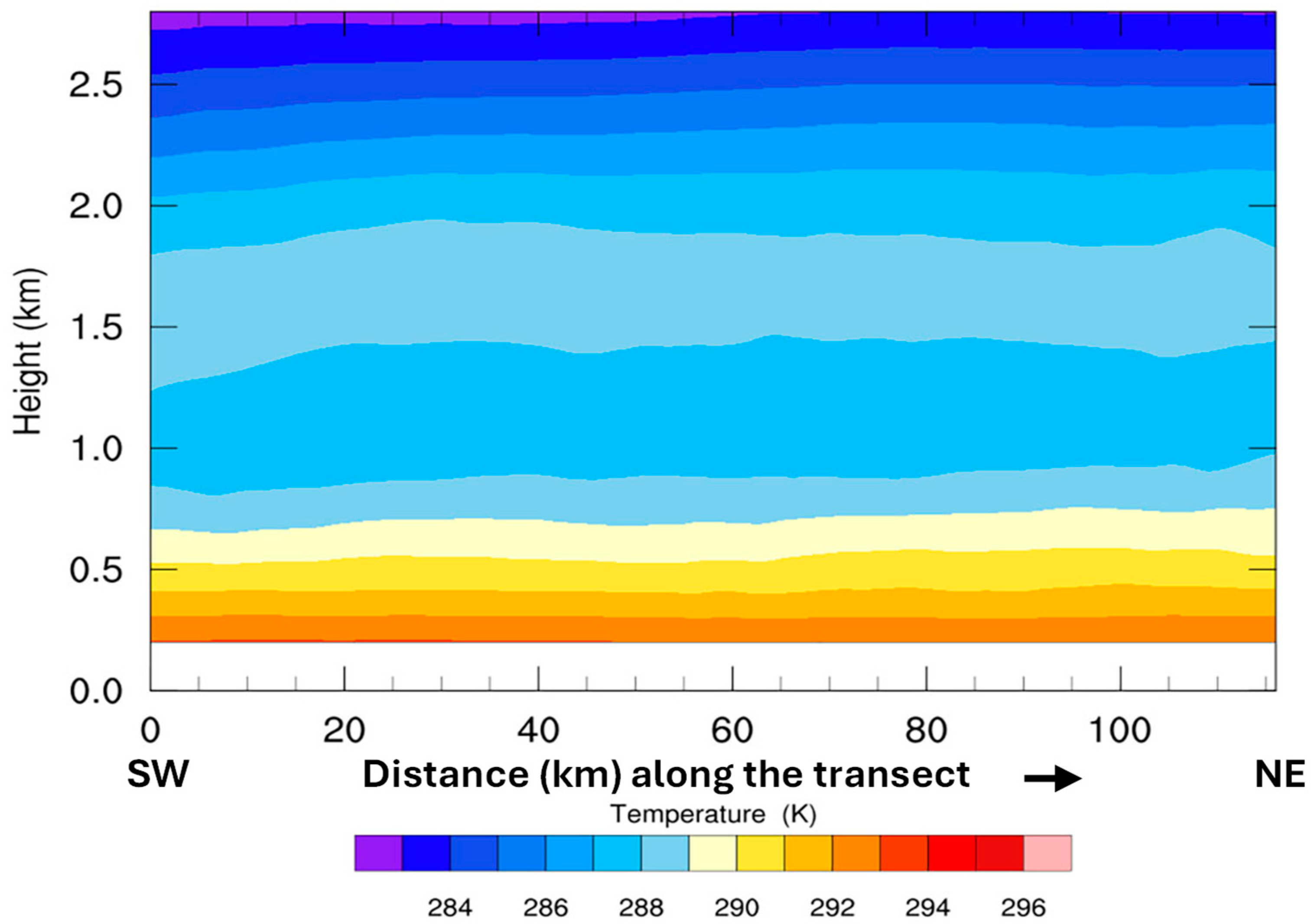The Urban Archipelago Effect: A Case Study in Morocco
Abstract
1. Introduction
2. Data, Model, and Method
2.1. Data
2.2. Model
2.3. Method
3. Results and Discussion
3.1. The Urban Heat Island
3.2. Simulated Results
4. Concluding Remarks
Author Contributions
Funding
Data Availability Statement
Conflicts of Interest
References
- World Bank Group. World Population, Demographic Statistics. Available online: https://data.worldbank.org/indicator/SP.POP.TOTL (accessed on 12 February 2024).
- Lall, S.V.; Selod, H. Rural-Urban Migration in Developing Countries: A Survey of Theoretical Predictions and Empirical Findings; World Bank Publications: Washington, DC, USA, 2006; Volume 3915. [Google Scholar]
- OECD; Sahel and West Africa Club. Africa’s Urbanisation Dynamics 2020: Africapolis, Mapping a New Urban Geography; West African Studies; OECD: Paris, France, 2020. [Google Scholar] [CrossRef]
- O’Neill, A. Morocco: Urbanization from 2013 to 2023; Statista: New York, NY, USA, 2025; Available online: https://www.statista.com/statistics/455886/urbanization-in-morocco/ (accessed on 20 May 2024).
- Bounoua, L.; Zhang, P.; Mostovoy, G.; Thome, K.; Masek, J.; Imhoff, M.; Shepherd, M.; Quattrochi, D.; Santanello, J.; Silva, J.; et al. Impact of Urbanization on US Surface Climate. Environ. Res. Lett. 2015, 10, 084010. [Google Scholar] [CrossRef]
- Grimmond, C.S.B. Climate of Cities. In The Routledge Handbook of Urban Ecology; Routledge: London, UK, 2010. [Google Scholar]
- Imhoff, M.L.; Zhang, P.; Wolfe, R.E.; Bounoua, L. Remote Sensing of the Urban Heat Island Effect across Biomes in the Continental USA. Remote Sens. Environ. 2010, 114, 504–513. [Google Scholar] [CrossRef]
- World Bank Group. Analysis of Heat Waves and Urban Heat Island Effects in Central European Cities and Implications for Urban Planning; PDF 151404; World Bank Group: Washington, DC, USA, 2020; Available online: http://documents.worldbank.org/curated/en/740251596528336330/Analysis-of-Heat-Waves-and-Urban-Heat-Island-Effects-in-Central-European-Cities-and-Implications-for-Urban-Planning (accessed on 14 August 2024).
- Zhang, P.; Imhoff, M.L.; Bounoua, L.; Wolfe, R.E. Exploring the Influence of Impervious Surface Density and Shape on Urban Heat Islands in the Northeast United States Using MODIS and Landsat. Can. J. Remote Sens. 2012, 38, 441–451. [Google Scholar]
- Fathi, N.; Bounoua, L.; Messouli, M. A Satellite Assessment of the Urban Heat Island in Morocco. Can. J. Remote Sens. 2019, 45, 26–41. [Google Scholar] [CrossRef]
- Bahi, H.; Rhinane, H.; Bensalmia, A.; Fehrenbach, U.; Scherer, D. Effects of Urbanization and Seasonal Cycle on the Surface Urban Heat Island Patterns in the Coastal Growing Cities: A Case Study of Casablanca, Morocco. Remote Sens. 2016, 8, 829. [Google Scholar] [CrossRef]
- Burian, S.J.; Shepherd, J.M. Effect of Urbanization on the Diurnal Rainfall Pattern in Houston. Hydrol. Process. 2005, 19, 1089–1103. [Google Scholar] [CrossRef]
- Ohashi, Y.; Kida, H. Effects of Mountains and Urban Areas on Daytime Local-Circulations in the Osaka and Kyoto Regions. J. Meteorol. Soc. Jpn. Ser. II 2002, 80, 539–560. [Google Scholar] [CrossRef]
- Gong, P.; Li, X.; Wang, J.; Bai, Y.; Chen, B.; Hu, T.; Liu, X.; Xu, B.; Yang, J.; Zhang, W.; et al. Annual Maps of Global Artificial Impervious Area (GAIA) between 1985 and 2018. Remote Sens. Environ. 2020, 236, 111510. [Google Scholar] [CrossRef]
- Marconcini, M.; Metz-Marconcini, A.; Üreyen, S.; Palacios-Lopez, D.; Hanke, W.; Bachofer, F.; Zeidler, J.; Esch, T.; Gorelick, N.; Kakarla, A.; et al. Outlining Where Humans Live, the World Settlement Footprint 2015. Sci. Data 2020, 7, 242. [Google Scholar] [CrossRef] [PubMed]
- Marconcini, M.; Metz- Marconcini, A.; Esch, T.; Gorelick, N. Understanding Current Trends in Global Urbanisation—The World Settlement Footprint Suite. GI_Forum 2021, 1, 33–38. [Google Scholar] [CrossRef]
- Chen, F.; Kusaka, H.; Bornstein, R.; Ching, J.; Grimmond, C.S.B.; Grossman-Clarke, S.; Loridan, T.; Manning, K.; Martilli, A.; Miao, S.; et al. The Integrated WRF/Urban Modeling System: Development, Evaluation, and Applications to Urban Environmental Problems. In Mechanical and Materials Engineering Faculty Publications and Presentations; Portland State University: Portland, OR, USA, 2011. [Google Scholar]
- Li, H.; Zhou, Y.; Wang, X.; Zhou, X.; Zhang, H.; Sodoudi, S. Quantifying Urban Heat Island Intensity and Its Physical Mechanism Using WRF/UCM. Sci. Total Environ. 2019, 650, 3110–3119. [Google Scholar] [CrossRef] [PubMed]
- Li, H.; Yuan, F.; Shen, L.; Liu, Y.; Zheng, Z.; Zhou, X. Improving the WRF/Urban Modeling System in China by Developing a National Urban Dataset. Geosci. Front. 2022, 13, 101385. [Google Scholar] [CrossRef]
- Tewari, M. Implementation and Verification of the Unified Noah Land Surface Model in the WRF Model. In Proceedings of the 20th Conference on Weather Analysis and Forecasting/16th Conference on Numerical Weather Prediction, Seattle, WA, USA, 12–16 January 2004. [Google Scholar]
- Kusaka, H.; Crook, A.; Dudhia, J.; Wada, K. Comparison of the WRF and MM5 Models for Simulation of Heavy Rainfall along the Baiu Front. SOLA 2005, 1, 197–200. [Google Scholar] [CrossRef]
- Skamarock, W.C.; Klemp, J.B.; Dudhia, J.; Gill, D.O.; Barker, D.M.; Duda, M.G.; Huang, X.-Y.; Wang, W.; Powers, J.G. A Description of the Advanced Research WRF Version 3; University Corporation for Atmospheric Research: Boulder, CO, USA, 2008. [Google Scholar]
- Oke, T.R. The Energetic Basis of the Urban Heat Island. Q. J. R. Meteorol. Soc. 1982, 108, 1–24. [Google Scholar] [CrossRef]
- Quattrochi, D.A. High Spatial Resolution Thermal Infrared Remote Sensing Data for Analysis of the Atlanta, Georgia, Urban Heat Island Effect and Its Impacts on the Environment. 2007. Available online: https://ntrs.nasa.gov/citations/20070032705 (accessed on 12 February 2024).
- Yanai, M.; Esbensen, S.; Chu, J.-H. Determination of Bulk Properties of Tropical Cloud Clusters from Large-Scale Heat and Moisture Budgets. J. Atmos. Sci. 1973, 30, 611–627. [Google Scholar]
- Landsberg, H.E. The Urban Climate; Academic Press: Cambridge, MA, USA, 1981. [Google Scholar]
- Kabisch, N.; Remahne, F.; Ilsemann, C.; Fricke, L. The Urban Heat Island under Extreme Heat Conditions: A Case Study of Hannover, Germany. Sci. Rep. 2023, 13, 23017. [Google Scholar] [CrossRef] [PubMed]
- Shepherd, M.J. Making Rain: Do Cities Impact Precipitation? Weatherwise 2005, 58, 28–31. [Google Scholar] [CrossRef]
- Wang, Q.; Zhang, C.; Ren, C.; Hang, J.; Li, Y. Urban Heat Island Circulations over the Beijing-Tianjin Region under Calm and Fair Conditions. Build. Environ. 2020, 180, 107063. [Google Scholar] [CrossRef]
- Zhao, L.; Lee, X.; Smith, M. The effect of urbanization on the spatial distribution of the UHI effect. Urban Clim. 2019, 28, 100452. [Google Scholar]











Disclaimer/Publisher’s Note: The statements, opinions and data contained in all publications are solely those of the individual author(s) and contributor(s) and not of MDPI and/or the editor(s). MDPI and/or the editor(s) disclaim responsibility for any injury to people or property resulting from any ideas, methods, instructions or products referred to in the content. |
© 2025 by the authors. Licensee MDPI, Basel, Switzerland. This article is an open access article distributed under the terms and conditions of the Creative Commons Attribution (CC BY) license (https://creativecommons.org/licenses/by/4.0/).
Share and Cite
Bounoua, L.; Zhang, T.; Thome, K.J.; Ed-dahmany, N.; Lachkham, M.A.; Bahi, H.; Yacoubi Khebiza, M.; Messouli, M. The Urban Archipelago Effect: A Case Study in Morocco. Urban Sci. 2025, 9, 97. https://doi.org/10.3390/urbansci9040097
Bounoua L, Zhang T, Thome KJ, Ed-dahmany N, Lachkham MA, Bahi H, Yacoubi Khebiza M, Messouli M. The Urban Archipelago Effect: A Case Study in Morocco. Urban Science. 2025; 9(4):97. https://doi.org/10.3390/urbansci9040097
Chicago/Turabian StyleBounoua, Lahouari, Tao Zhang, Kurtis John Thome, Noura Ed-dahmany, Mohamed Amine Lachkham, Hicham Bahi, Mohammed Yacoubi Khebiza, and Mohammed Messouli. 2025. "The Urban Archipelago Effect: A Case Study in Morocco" Urban Science 9, no. 4: 97. https://doi.org/10.3390/urbansci9040097
APA StyleBounoua, L., Zhang, T., Thome, K. J., Ed-dahmany, N., Lachkham, M. A., Bahi, H., Yacoubi Khebiza, M., & Messouli, M. (2025). The Urban Archipelago Effect: A Case Study in Morocco. Urban Science, 9(4), 97. https://doi.org/10.3390/urbansci9040097





